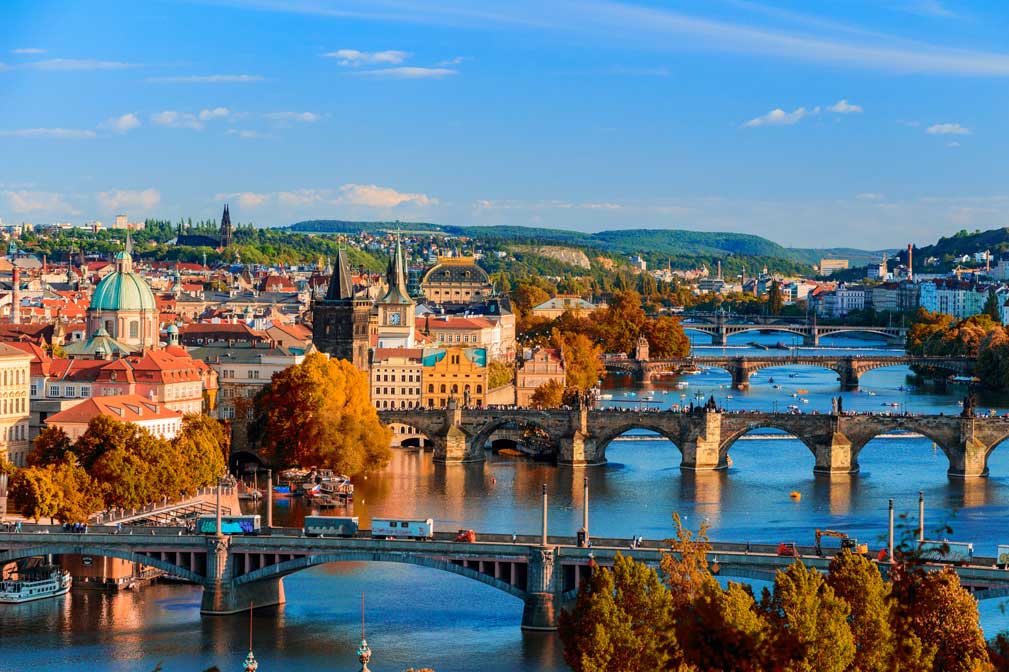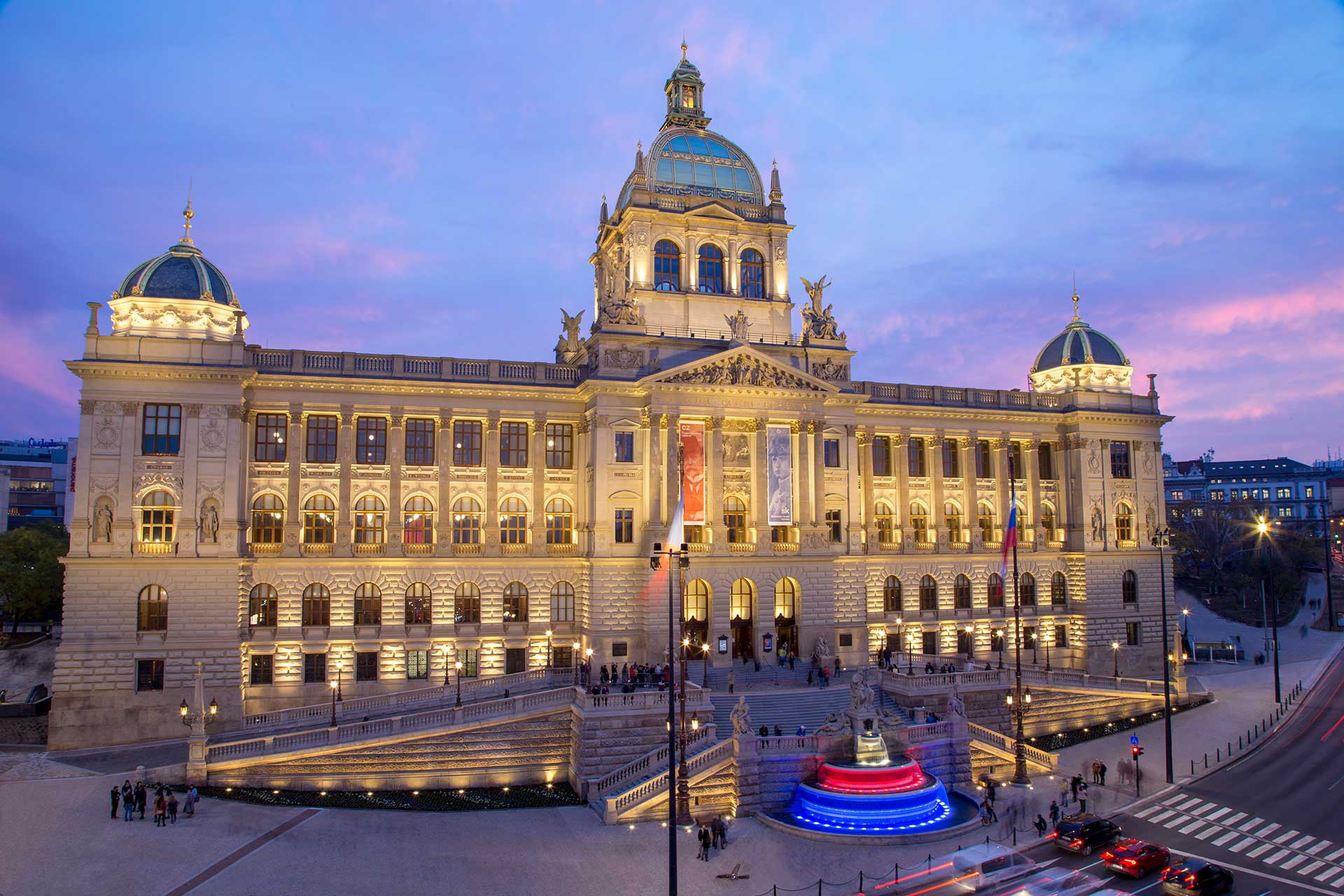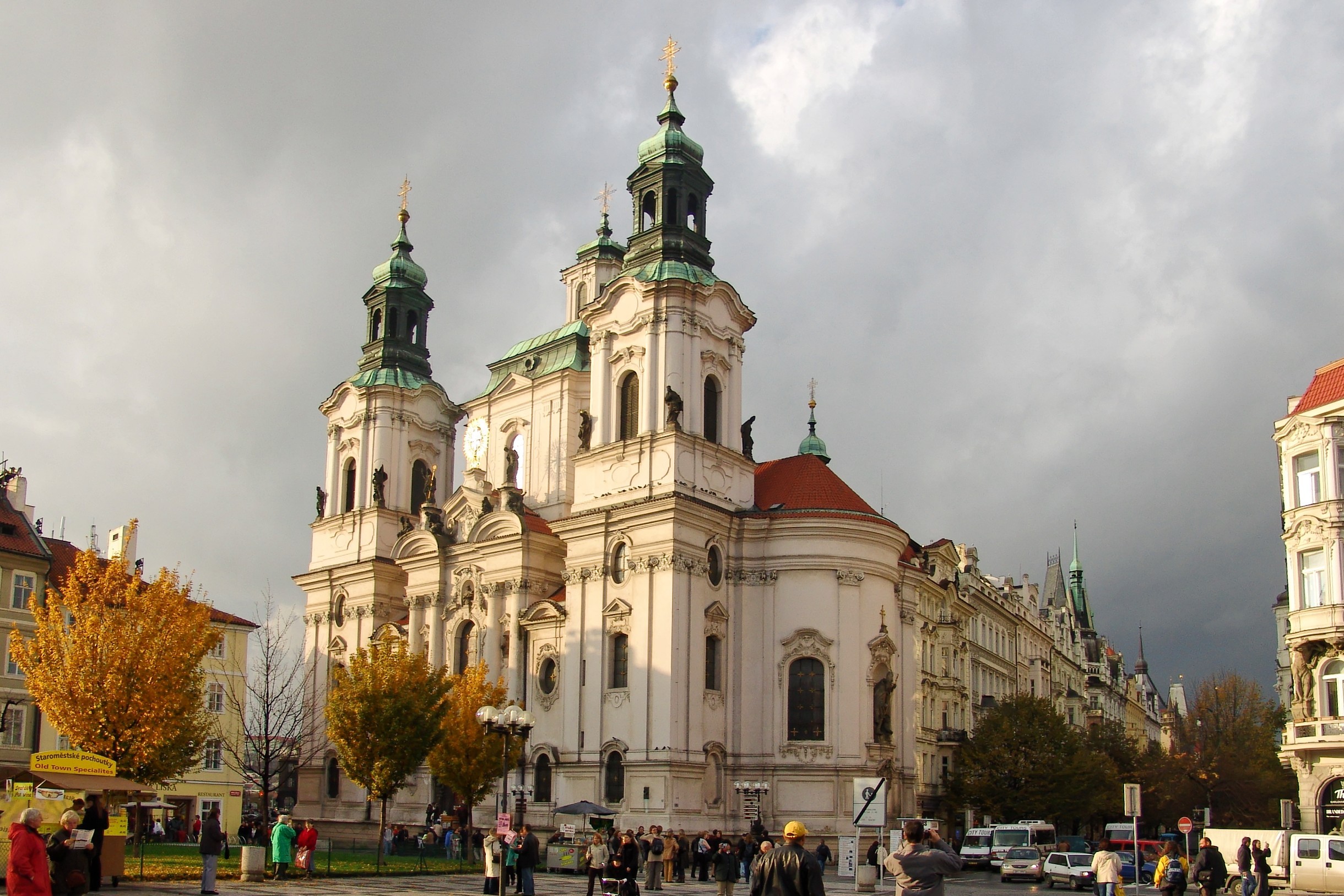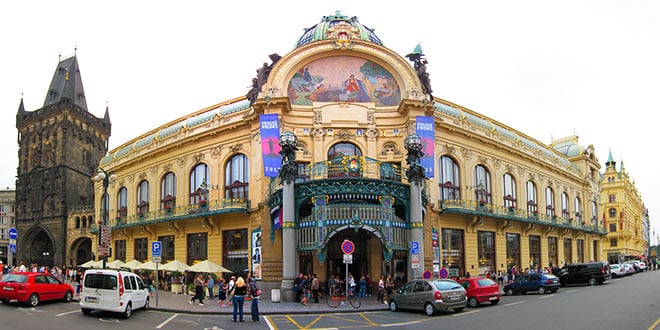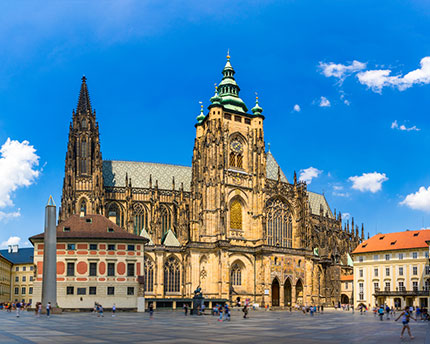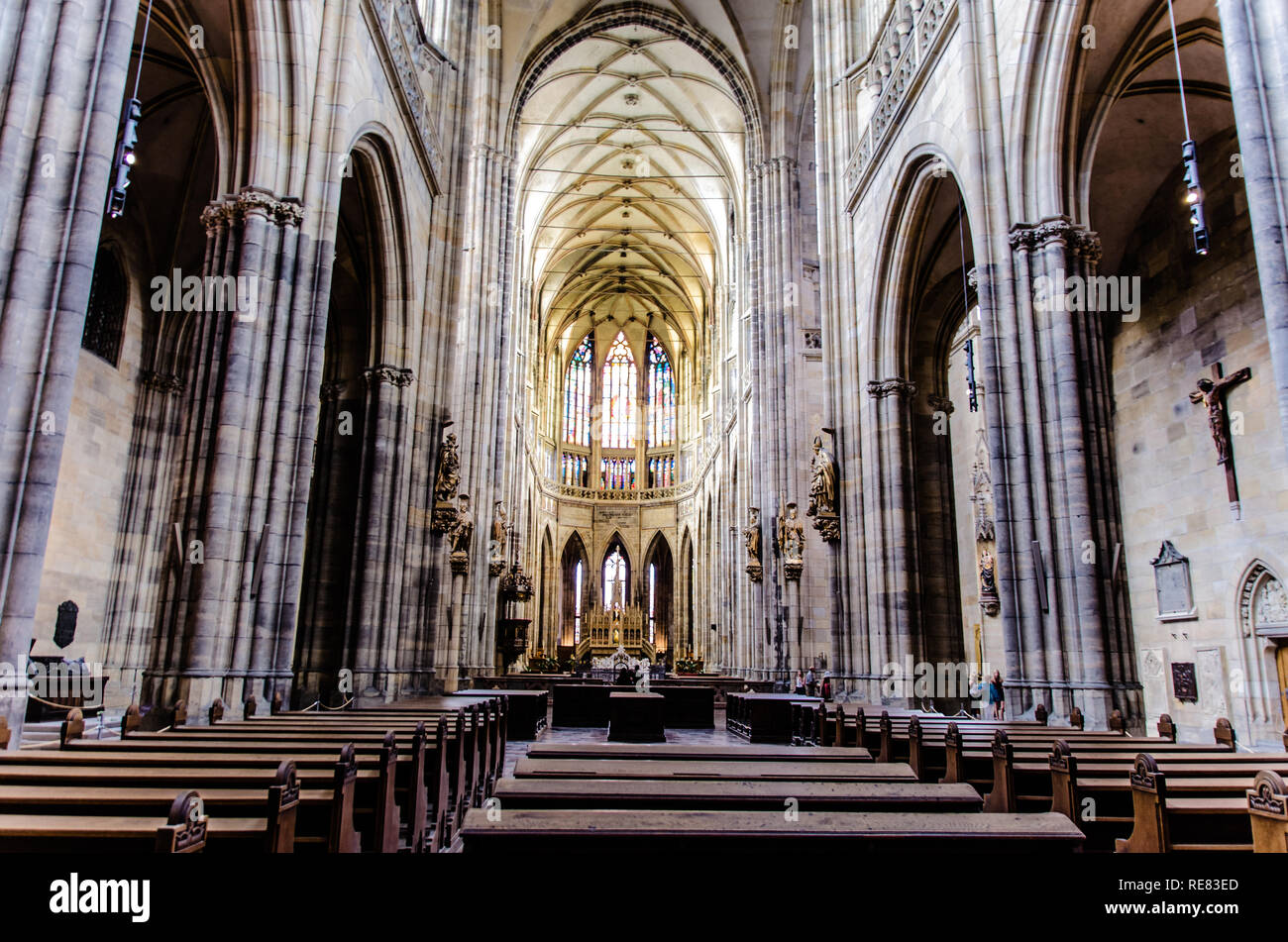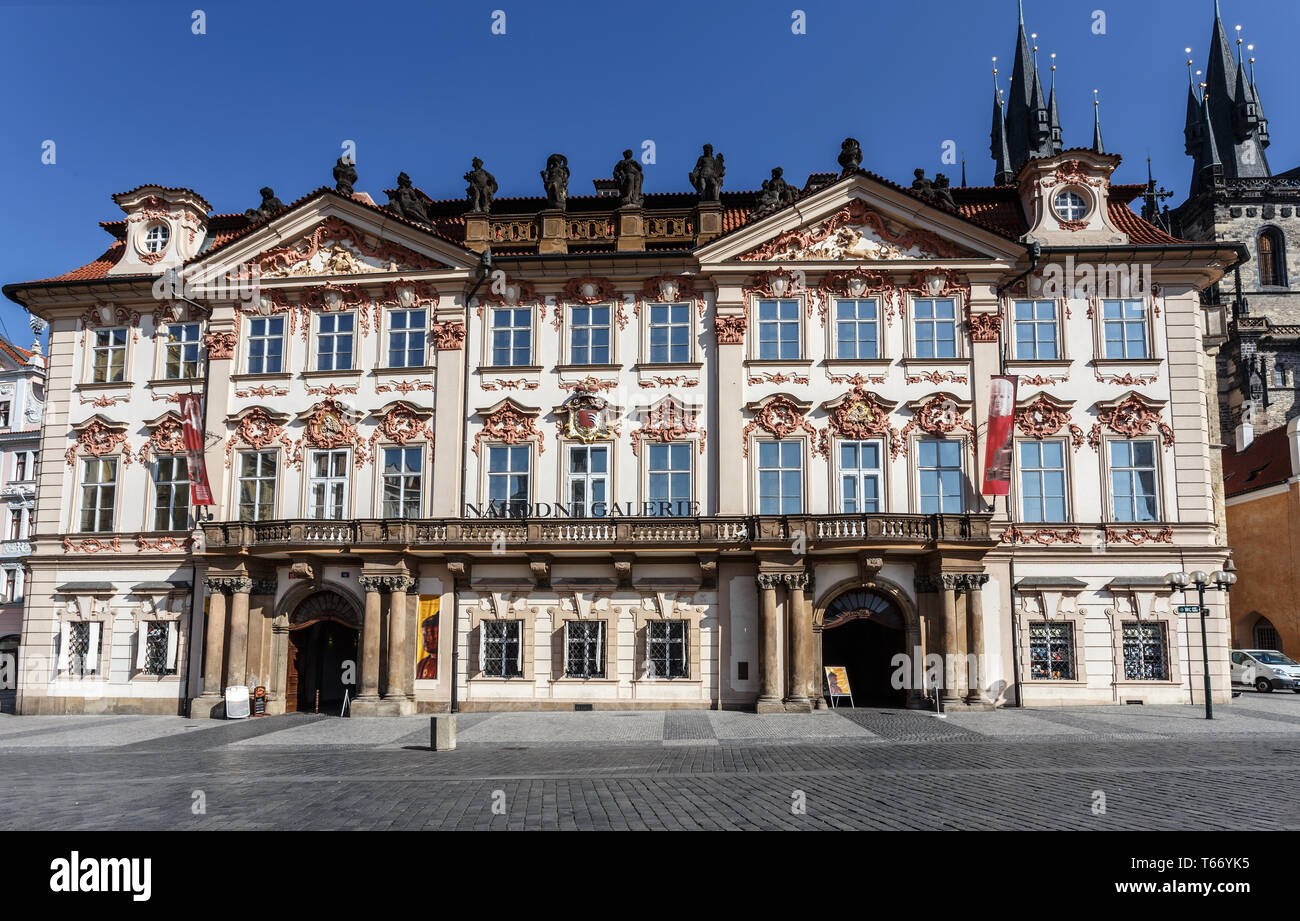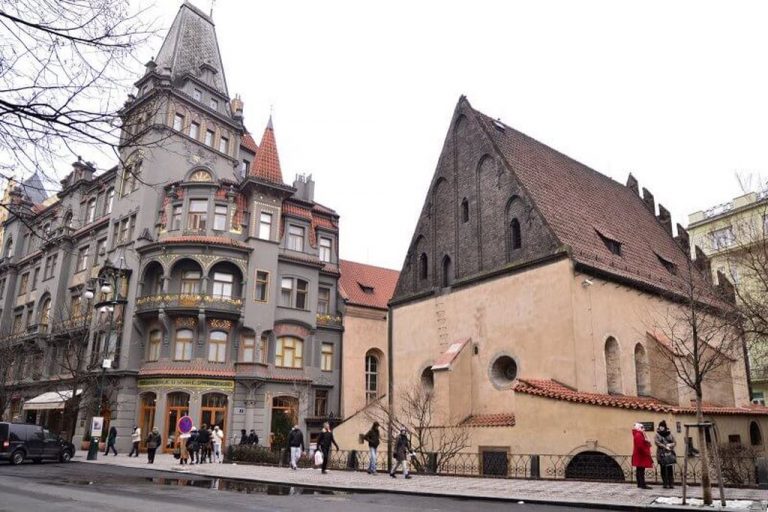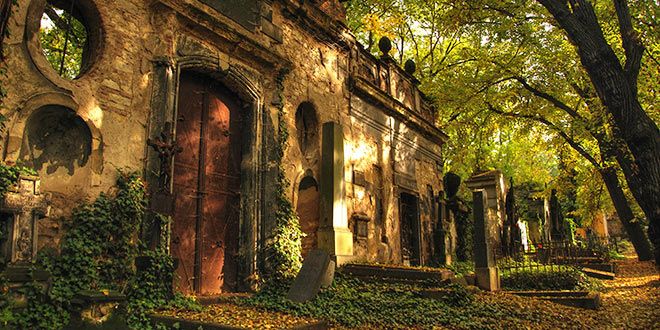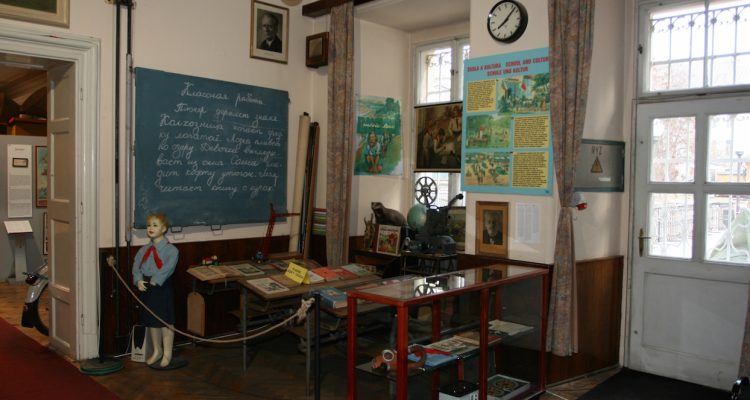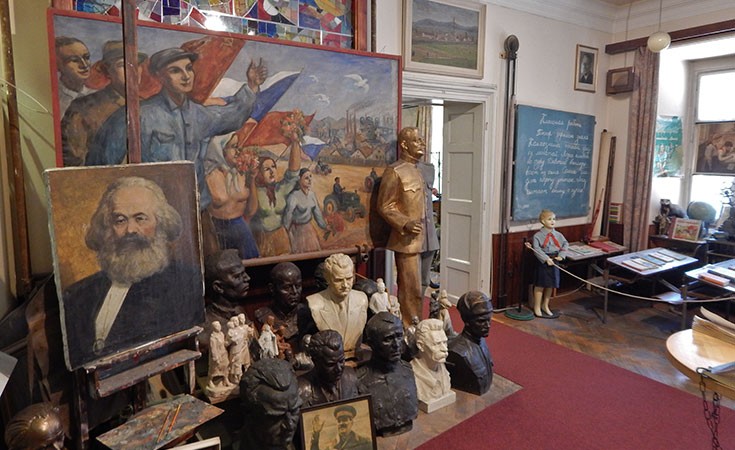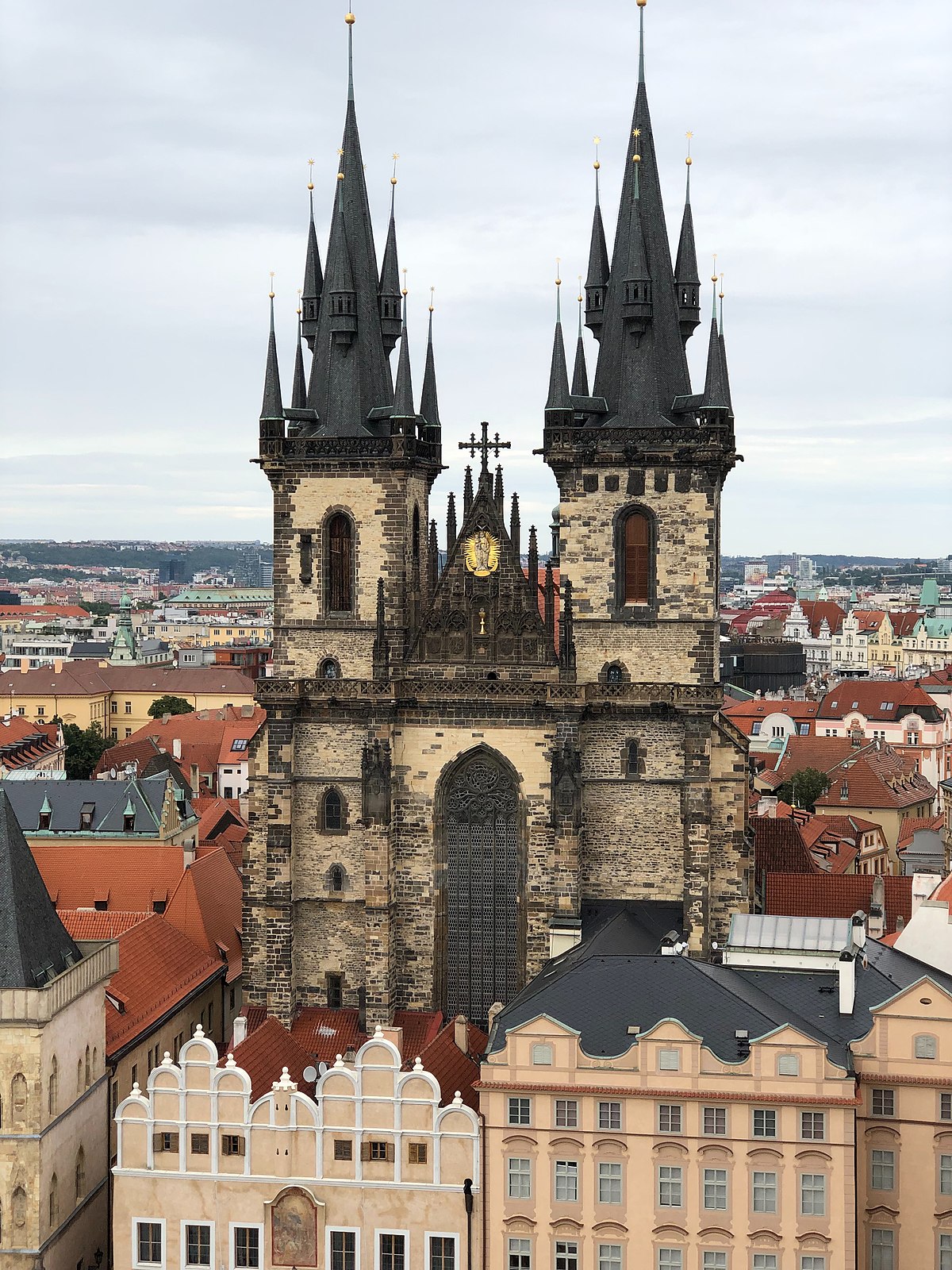Prague Castle
Located in Prague’s Hradcany neighborhood, Prague Castle (Pražský hrad), once the home of Bohemia’s kings, is today the official residence of the Czech Republic’s President and one of the city’s most visited tourist attractions. Originally built as a walled fortress around AD 870, the castle has changed dramatically over the years and contains examples of most of the leading architectural styles of the last millennium. Within the castle walls are a number of Prague’s most popular tourist sites, including St. Vitus Cathedral, St. George’s Basilica, the Powder Tower, the Old Royal Palace, and the Golden Lane.
Situat în cartierul Hradcany din Praga, Castelul din Praga (Pražský hrad), cândva casa regilor Boemiei, este astăzi reședința oficială a președintelui Republicii Cehe și una dintre cele mai vizitate atracții turistice ale orașului. Construit inițial ca o cetate cu ziduri în jurul anului 870 d.Hr., castelul s-a schimbat dramatic de-a lungul anilor și conține exemple ale majorității stilurilor arhitecturale de vârf din mileniul trecut. În interiorul zidurilor castelului se află mai multe dintre cele mai populare obiective turistice din Praga, inclusiv Catedrala Sf. Vitus, Bazilica Sf. Gheorghe, Turnul Pulberii, Vechiul Palat Regal și Banda de Aur.
The National Museum
Fresh from a seven-year-long renovation, the National Museum (Národní Muzeum) in Prague is spread across a number of locations and houses numerous important collections representing a variety of fields, with literally millions of items covering mineralogy, zoology, anthropology, and archaeology, as well as the arts and music. The entomology collection alone numbers more than five million specimens. The oldest museum in the Czech Republic, it was established in the early 1800s before moving to its current location in 1891.
Proaspăt obținut după o renovare de șapte ani, Muzeul Național (Muzeul Národní) din Praga este răspândit în mai multe locații și găzduiește numeroase colecții importante care reprezintă o varietate de domenii, cu literalmente milioane de articole care acoperă mineralogie, zoologie, antropologie și arheologie, precum și arte și muzică. Numai colecția de entomologie numără mai mult de cinci milioane de exemplare. Cel mai vechi muzeu din Republica Cehă, a fost înființat la începutul anilor 1800 înainte de a se muta în locația actuală în 1891.
The Strahov Monastery and Library
The Strahov Monastery and Library (Strahovsky kláster) dates back to the 12th century and is the second oldest monastery in Prague. While its imposing gateway and churches are impressive enough, its most important buildings are its two beautifully decorated Baroque libraries. The Philosophical Library contains a variety of extraordinary furnishings, along with an exquisite ceiling painted by Franz Anton Maulbertsch entitled Enlightenment. The second library, the Theological Library, consists of a splendid Baroque room with a beautiful ornate painted ceiling by Siard Nosecky, a Strahov Monk, along with superb ceiling frescoes framed by detailed stucco work. The libraries contain many rare old volumes and manuscripts, including the famous 9th-century Strahov Gospel, while in the cellars are old printing presses along with the remains of St. Norbert, founder of the Premonstratensian Order.
Mănăstirea și Biblioteca Strahov (Strahovsky kláster) datează din secolul al XII-lea și este a doua cea mai veche mănăstire din Praga. În timp ce poarta sa impozantă și bisericile sunt suficient de impresionante, cele mai importante clădiri ale sale sunt cele două biblioteci baroce frumos decorate. Biblioteca filozofică conține o varietate de mobilier extraordinar, împreună cu un tavan rafinat pictat de Franz Anton Maulbertsch intitulat Iluminism. A doua bibliotecă, Biblioteca teologică, constă dintr-o splendidă cameră barocă, cu un frumos tavan pictat ornamentat de Siard Nosecky, un călugăr Strahov, împreună cu superbe fresce din tavan încadrate de lucrări detaliate de stuc. Bibliotecile conțin numeroase volume și manuscrise vechi rare, inclusiv faimoasa Evanghelie Strahov din secolul al IX-lea, în timp ce în pivnițe se găsesc tipografii vechi împreună cu rămășițele Sfântului Norbert, fondatorul Ordinului premonstratensian.
St. Nicholas Church
On picturesque Little Quarter Square in the Old Town area stands St. Nicholas Church (Kostel svatého Mikuláše), one of Prague’s newer churches. Built by Jesuits in the 18th century, it’s a fine example of High Baroque and is notable for its splendid interior with its unique 19th-century chandelier, as well as the large Baroque paintings by Czech artist Karel Skreta that adorn the huge cupola.
Pe pitorescul cartier mic din cartierul orașului vechi se află Biserica Sf. Nicolae (Kostel svatého Mikuláše), una dintre cele mai noi biserici din Praga. Construită de iezuiți în secolul al XVIII-lea, este un excelent exemplu de baroc înalt și se remarcă prin interiorul său splendid, cu candelabrul său unic din secolul al XIX-lea, precum și picturile mari baroce ale artistului ceh Karel Skreta, care împodobesc cupola uriașă.
Golden Lane – Playground for Alchemists
The mysterious Golden Lane, so called because, according to legends, alchemists had to look on this street to find a reaction to turn ordinary materials into gold. Despite the streets name, it is debated whether alchemists ever worked or lived here. Czech-Jewish writer Franz Kafka used a house on the street for around two years as he enjoyed the peaceful environment it provided whilst writing.
Misteriosul Golden Lane, așa numit pentru că, potrivit legendelor, alchimiștii au trebuit să se uite pe această stradă pentru a găsi o reacție care să transforme materialele obișnuite în aur. În ciuda numelui străzilor, se dezbate dacă alchimiștii au lucrat sau au trăit vreodată aici. Scriitorul ceh-evreu Franz Kafka a folosit o casă pe stradă timp de aproximativ doi ani, în timp ce se bucura de mediul liniștit pe care îl oferea în timp ce scria.
The Municipal House
The Prague Municipal House (Obecní dum) is widely considered one of the finest examples of Art Nouveau in the city. Built in 1912, this splendid civic building is also home to one of Prague’s most important (and largest) concert venues, Smetana Hall, and boasts numerous striking features, from its sumptuous façade with a large mural on the arch above the second floor balcony, to the large dome that rests behind and above the arch. The interior is equally impressive and includes many fine stained glass windows and important paintings.
Casa Municipală din Praga (Obecní dum) este considerată pe scară largă unul dintre cele mai bune exemple de Art Nouveau din oraș. Construită în 1912, această splendidă clădire civică găzduiește, de asemenea, unul dintre cele mai importante (și mai mari) săli de concerte din Praga, Sala Smetana și se mândrește cu numeroase caracteristici izbitoare, de la fațada sa somptuoasă, cu o pictură murală mare pe arcada de deasupra balconului de la etajul al doilea, la cupola mare care se odihnește în spatele și deasupra arcului. Interiorul este la fel de impresionant și include multe vitralii fine și picturi importante.
Charles Bridge
One of the most recognizable old bridges in Europe, magnificent Charles Bridge (Karluv Most) boasts 32 unique points of interest along its 621-meter span. Built in 1357, the bridge has long been the subject of a great deal of superstition, including the builders having laid the initial bridge stone on the 9th of July at exactly 5:31am, a precise set of numbers (135797531) believed to give the structure additional strength. For added good measure, it was constructed in perfect alignment with the tomb of St. Vitus and the setting sun on the equinox. The bridge is particularly famous for its many fine old statues. Among the most important are those of Holy Roman Emperor Charles IV and John of Nepomuk, the country’s most revered saint, unveiled in 1683 (a more recent superstition involves rubbing the plaque at the base of the statue for the granting of a wish).
Unul dintre cele mai recunoscute poduri vechi din Europa, magnificul Pod Charles (Karluv Most) se mândrește cu 32 de puncte de interes unice de-a lungul ariei sale de 621 de metri. Construit în 1357, podul a făcut mult timp obiectul unei mari superstiții, inclusiv constructorii care au așezat piatra inițială a podului pe 9 iulie exact la 5:31 dimineața, un set precis de numere (135797531) despre care se crede că oferă structura rezistență suplimentară. Pentru o măsură mai bună, a fost construit în perfectă aliniere cu mormântul Sfântului Vit și soarele care apune la echinocțiul. Podul este deosebit de renumit pentru numeroasele sale statui vechi fine. Printre cele mai importante se numără cele ale împăratului Sfântului Roman Carol al IV-lea și ale lui Ioan de Nepomuc, cel mai venerat sfânt al țării, dezvăluit în 1683 (o superstiție mai recentă presupune frecarea plăcii de la baza statuii pentru acordarea unei dorințe).
St. Vitus Cathedral
Situated within the grounds of Prague Castle, the Roman Catholic St. Vitus Cathedral (Katedrala St. Vita) is the Czech Republic’s largest and most important Christian church. Seat of the Archbishop of Prague, it’s also home to the tombs of numerous saints and three Bohemian kings. Founded on the site of a Romanesque rotunda built in AD 925, the cathedral was started in 1344 and took more than 525 years to complete, resulting in a mix of modern Neo-Gothic and 14th-century Gothic styles, along with Baroque and Renaissance influences. Interior highlights include stunning stained glass windows depicting the Holy Trinity, a mosaic from 1370 (The Last Judgment), and the St. Wenceslas Chapel (Svatovaclavska kaple) with its spectacular jewel-encrusted altar with more than 1,300 precious stones. Also of note, although rarely displayed, are the Czech crown jewels.
Situată în incinta Castelului Praga, Catedrala Romano-Catolică Sfântul Vitus (Katedrala St. Vita) este cea mai mare și cea mai importantă biserică creștină a Republicii Cehe. Scaunul arhiepiscopului de Praga, găzduiește și mormintele a numeroși sfinți și a trei regi boemi. Fondată pe locul unei rotunde romanice construită în anul 925 d.Hr., catedrala a fost începută în 1344 și a durat mai mult de 525 de ani pentru a finaliza, rezultând un amestec de stiluri neogotice moderne și gotice din secolul al XIV-lea, alături de influențe baroce și renascentiste. . Punctele de atracție interioare includ vitralii uimitoare care descriu Sfânta Treime, un mozaic din 1370 (Judecata de Apoi) și Capela Sf. Venceslau (Svatovaclavska kaple) cu altarul său spectaculos încrustat cu bijuterii, cu peste 1.300 de pietre prețioase. De asemenea, de remarcat, deși sunt rareori afișate, sunt bijuteriile coroanei cehe.
The Dancing House
The Dancing House (Tancící dum), Prague’s most outstanding modern architectural creation, was built between 1992 and 1996 to designs by Frank Gehry. Consisting of two adjoining towers, this splendid structure features unique curves that resemble two dancing figures, an effect heightened by the fact one of the towers is shaped like a woman wearing a skirt (hence the nickname „Fred and Ginger” after famous American dancers Fred Astaire and Ginger Rogers).
Casa dansatoare (Tancící dum), cea mai remarcabilă creație arhitecturală modernă din Praga, a fost construită între 1992 și 1996 după proiectele lui Frank Gehry. Compusă din două turnuri alăturate, această splendidă structură prezintă curbe unice care seamănă cu două figuri dansatoare, efect sporit de faptul că unul dintre turnuri are forma unei femei purtând o fustă (de aici porecla „Fred și Ginger” după celebrul dansator american Fred Astaire și Ginger Rogers).
The National Gallery in Prague
The National Gallery in Prague (Národní galerie v Praze) is home to some of Europe’s most important art collections. The bulk of the collection is housed in the Veletrzní Palace (Veletrzní Palác), a relatively modern structure built in 1925 that holds the 19th- to 21st-century works. While there’s a strong emphasis on Czech artists, foreign artists such as Monet and Picasso are included, as are other art forms such as photography, fashion, applied arts, and sculpture. Other notable works are held in the Kinsky Palace (Palác Kinskych), home to Asian art, art from the ancient world, and the gallery’s Baroque collections, and at the Convent of St. Agnes of Bohemia, where you’ll find European art from the Middle Ages. Finally, the splendid 17th-century Sternberg Palace (Sternbersky Palác) houses some of the gallery’s most famous pieces, focusing on European art from the Classical era to the end of the Baroque period and including important ancient Greek and Roman pieces; 14th- to 16th-century Italian masterpieces; and 16th- to 18th-century works by artists such as El Greco, Goya, Rubens, van Dyck, Rembrandt, and van Goyen.
Galeria Națională din Praga (Národní galerie v Praze) găzduiește unele dintre cele mai importante colecții de artă din Europa. Cea mai mare parte a colecției este găzduită în Palatul Veletrzní (Veletrzní Palác), o structură relativ modernă construită în 1925 care deține lucrările din secolele XIX-XXI. În timp ce se pune un accent puternic pe artiștii cehi, sunt incluși artiști străini precum Monet și Picasso, la fel și alte forme de artă precum fotografia, moda, artele aplicate și sculptura. Alte lucrări notabile sunt ținute în Palatul Kinsky (Palác Kinskych), care găzduiește arta asiatică, arta din lumea antică și colecțiile baroce ale galeriei și la Mănăstirea Sf. Agnes din Boemia, unde veți găsi arta europeană din Evul Mediu. În cele din urmă, splendidul Palat Sternberg din secolul al XVII-lea (Sternbersky Palác) găzduiește unele dintre cele mai faimoase piese ale galeriei, concentrându-se pe arta europeană de la epoca clasică până la sfârșitul perioadei baroce și incluzând importante piese antice grecești și romane; Capodopere italiene din secolele XIV-XVI; și lucrări din secolele XVI-XVIII ale unor artiști precum El Greco, Goya, Rubens, van Dyck, Rembrandt și van Goyen.
KGB Museum
This small museum was established by a Russian enthusiast and houses a large variety of memorabilia relating to the secret police of the Soviet Union. You may well be shown around by the collector himself and you can expect to find an assortment of spy cameras, secret weapons and interrogation equipment. Another interesting exhibit within the museum are the photographs of Prague taken by a KGB officer in the year of 1968 in which the streets of the city appear eerily empty.
Acest mic muzeu a fost înființat de un entuziast rus și găzduiește o mare varietate de suveniruri legate de poliția secretă a Uniunii Sovietice. S-ar putea să fii prezentat de colecționarul însuși și te poți aștepta să găsești un sortiment de camere spion, arme secrete și echipamente de interogare. O altă expoziție interesantă din cadrul muzeului sunt fotografiile din Praga făcute de un ofițer KGB în anul 1968, în care străzile orașului apar uimitor de goale.
The Petrín Lookout Tower
Named after the hill on which it stands, the 63.5-meter-high Petrín Lookout Tower (Petrínská rozhledna) is a little like a smaller version of the Eiffel Tower in Paris that offers panoramic views over Prague. Although only a fifth the size of its French counterpart, the tower’s elevation creates the illusion that it’s bigger than it actually is. Built in 1891 for the Prague Exhibition from disused railway tracks, it was later moved to Petrín Hill in the 1930s, where it became one of the city’s major tourist attractions.
Numit după dealul pe care se află, Turnul Petrín Lookout (Petrínská rozhledna), înalt de 63,5 metri, seamănă puțin cu o versiune mai mică a Turnului Eiffel din Paris, care oferă vederi panoramice asupra Pragei. Deși doar o cincime din mărimea omologului său francez, înălțimea turnului creează iluzia că este mai mare decât este de fapt. Construit în 1891 pentru Expoziția de la Praga din căile ferate dezafectate, ulterior a fost mutat pe dealul Petrín în anii 1930, unde a devenit una dintre atracțiile turistice majore ale orașului.
The Hilltop Fortress: Vyšehrad
Looking like something out of a fairy tale, the Vyšehrad fortress—literally translated as the „Upper Castle,” or the „Castle on the Heights”—stands high above the Vltava River overlooking Prague. Known to have been in existence as far back as the 10th century, it has long been the subject of myth and legend. Once the royal residence of Vratislav II, Vyšehrad also played a role as part of the original Royal Route taken by kings about to be crowned, who would have to stop here to pay tribute to their predecessors.
Arătând ca ceva dintr-un basm, cetatea Vyšehrad – literalmente tradusă ca „Castelul superior” sau „Castelul de pe înălțimi” – se află deasupra râului Vltava, cu vedere la Praga. Se știe că a existat încă din secolul al X-lea, a fost mult timp subiectul mitului și legendei. Odată cu reședința regală a lui Vratislav al II-lea, Vyšehrad a jucat, de asemenea, un rol ca parte a Traseului Regal inițial parcurs de regi pe cale să fie încoronat, care ar trebui să se oprească aici pentru a aduce tribut predecesorilor lor.
Josefov: The Jewish Quarter
Prague’s Jewish Quarter was originally located in the Castle District, but by the 1200s had spread to the city’s Josefov area and was for centuries regarded as a ghetto. Its transformation into one of the city’s most important and interesting districts took place in the late 1800s, when large sections were demolished to make way for Art Nouveau apartment buildings. Josefov includes the Jewish Museum in Prague (Židovské muzeum v Praze), an important attraction that consists of the Maisel Synagogue, the Spanish Synagogue, the Pinkas Synagogue, the Ceremonial Hall, and the Klaus Synagogue.
Cartierul evreiesc din Praga a fost situat inițial în districtul Castelului, dar până în anii 1200 se răspândise în zona orașului Josefov și a fost considerat timp de secole ca un ghetou. Transformarea sa într-unul dintre cele mai importante și interesante cartiere ale orașului a avut loc la sfârșitul anilor 1800, când au fost demolate secțiuni mari pentru a face loc clădirilor de apartamente Art Nouveau. Josefov include Muzeul Evreiesc din Praga (Židovské muzeum v Praze), o atracție importantă care constă în Sinagoga Maisel, Sinagoga Spaniolă, Sinagoga Pinkas, Sala Ceremonială și Sinagoga Klaus.
The Olšany Cemetery
Created in 1680 to accommodate Prague’s many plague victims, the Olšany Cemetery (Olšanské hrbitovy) served as the city’s main burial ground for centuries and is the final resting place of countless victims of disease and war. Large enough to hold an estimated two million graves and divided into sections, the graveyard consists of the Jewish Cemetery, which includes the grave of writer Franz Kafka, and the Christian Cemetery, where you’ll find the final resting place of a more recent notable Czech, Jan Palach, who set himself on fire in 1968 in protest against the Soviet invasion. Although his body was taken from Olsany Cemetery in 1973 to prevent his grave from becoming the site of organized protests, his coffin was returned in 1990.
Creat în 1680 pentru a găzdui numeroasele victime ale ciumei din Praga, cimitirul Olšany (Olšanské hrbitovy) a servit drept cimitir principal al orașului timp de secole și este ultimul loc de odihnă al nenumăratelor victime ale bolilor și ale războiului. Suficient de mare pentru a găzdui aproximativ două milioane de morminte și împărțit în secțiuni, cimitirul este alcătuit din cimitirul evreiesc, care include mormântul scriitorului Franz Kafka și cimitirul creștin, unde veți găsi ultimul loc de odihnă al unui notabil mai recent ceh, Jan Palach, care s-a incendiat în 1968 ca protest împotriva invaziei sovietice. Deși trupul său a fost luat de la cimitirul Olsany în 1973 pentru a împiedica mormântul său să devină locul protestelor organizate, sicriul său a fost returnat în 1990.
Seven Foot Tall Sigmund Freud
Walk through the sublime urban area of Stare Mesto within the Old Town of Prague and look to the sky. You will be surprised to find a seven foot tall sculpture of the world famous psycho-analyst Sigmund Freud hanging from a metal beam above the cobbled streets at your feet. The unusual artwork has proven so popular that it has been exhibited in cities all over the world including Chicago, London and Berlin. Often mistaken for a suicide attempt, the sculpture has also been responsible for several calls to the emergency services since its creation.
Mergeți prin zona urbană sublimă a lui Stare Mesto din orașul vechi din Praga și priviți spre cer. Veți fi surprins să găsiți o sculptură înaltă de 7 metri, a renumitului psihoanalist mondial Sigmund Freud, atârnând de o grindă metalică deasupra străzilor pietruite de la picioarele voastre. Opera de artă neobișnuită s-a dovedit atât de populară încât a fost expusă în orașe din întreaga lume, inclusiv Chicago, Londra și Berlin. Adesea confundată cu o tentativă de sinucidere, sculptura a fost, de asemenea, responsabilă de mai multe apeluri către serviciile de urgență de la crearea sa.
The Old Town Square and the Astronomical Clock
The historic center of Prague, the Old Town (Staré Mesto) is where you’ll find the splendid Old Town Square (Staromestské námestí). Here, you’ll find the Tyn Church and the Clementinum, along with numerous other fine old churches, as well as splendid old architecture dating back as far as the 11th century, while the Jewish Quarter, Josefov, is just a short walk north. A highlight is the Old Town Hall (Staromestská radnice), home to the wonderful early 15th-century Astronomical Clock (orloj). Each hour, it springs to life as the 12 Apostles and other figures appear and parade in procession across the clock face. Other Old Town Hall highlights are the Gothic doorway leading to its splendid interior with its art exhibits and displays, a chapel built in 1381, and an old prison.
Centrul istoric al Pragei, Orașul Vechi (Staré Mesto) este locul unde veți găsi splendida Piață a Orașului Vechi (Staromestské námestí). Aici veți găsi Biserica Tyn și Clementinum, împreună cu numeroase alte biserici vechi fine, precum și splendida arhitectură veche datând din secolul al XI-lea, în timp ce Cartierul Evreiesc, Josefov, este la doar o scurtă plimbare spre nord. Un punct culminant este Primăria Veche (Staromestská radnice), care găzduiește minunatul Ceas Astronomic de la începutul secolului al XV-lea (orloj). În fiecare oră, el prinde viață pe măsură ce cei 12 apostoli și alte figuri apar și defilează în procesiune pe fața ceasului. Alte atracții ale primăriei vechi sunt ușa gotică care duce la interiorul său splendid, cu exponatele și expozițiile sale de artă, o capelă construită în 1381 și o închisoare veche.
Communism Museum
Europe is a continent rich in history and political turmoil and the Czech Republic does not buck that trend. The country was a communist nation from 1948 until the revolution of 1989. Under communist rule, more than 200,000 Czechs were arrested and 327 shot dead as they attempted to flee the country. Inside the communism museum you will find photographs, films and even sculptures documenting the state-sponsored terrorism that occurred under communist rule.
Europa este un continent bogat în istorie și frământări politice, iar Republica Cehă nu încetinește această tendință. Țara a fost o națiune comunistă din 1948 până la revoluția din 1989. Sub conducerea comunistă, peste 200.000 de cehi au fost arestați și 327 morți în timp ce încercau să fugă din țară. În interiorul muzeului comunismului veți găsi fotografii, filme și chiar sculpturi care documentează terorismul sponsorizat de stat care a avut loc sub conducerea comunistă.
The Church of Our Lady before Týn
One of Prague’s most recognizable buildings is the Church of Our Lady before Týn (Kostel Matky Boží pred Týnem), often abbreviated to simply Týn Church. Unmistakable for its twin 80-meter-tall spires flanking each side of the building (each supporting four smaller spires), its main entrance is through a narrow passage past the houses obscuring its façade. Although completed in the 15th century, the church was altered numerous times through the centuries as the city’s allegiances changed, inside are numerous fine tombs, the superb Gothic northern portal with its Crucifixion sculpture, early Baroque altarpiece paintings dating from 1649, and one of Europe’s finest 17th-century pipe organs.
Una dintre cele mai recunoscute clădiri din Praga este Biserica Maicii Domnului de dinainte de Týn (Kostel Matky Boží pred Týnem), adesea prescurtată în simpla Biserică Týn. Inconfundabilă pentru turlele sale duble de 80 de metri înălțime care flancează fiecare parte a clădirii (fiecare susținând patru turnuri mai mici), intrarea sa principală este printr-un pasaj îngust care trece peste case care îi ascund fațada. Deși a fost finalizată în secolul al XV-lea, biserica a fost modificată de mai multe ori de-a lungul secolelor, pe măsură ce loialitățile orașului s-au schimbat, în interior sunt numeroase morminte fine, superbul portal nordic gotic cu sculptura crucificării, picturile de altar din baroc timpuriu datând din 1649 și una dintre cele mai bune orgi din Europa din secolul al XVII-lea.
The National Theatre
Idyllically perched on the banks of the River Vltava, Prague’s National Theatre is a must-visit for lovers of the performing arts. Home to the country’s top opera, ballet, and drama performances, the National Theater was opened in 1881 as a symbol of Czech national identity and to promote the Czech language and culture. Despite a somewhat checkered past that saw the building destroyed by fire and even closed by the communists, this stunning theater has undergone extensive renovations and stands as a monument to the city’s rich talent and cultural significance.
Situat idilic pe malurile râului Vltava, Teatrul Național din Praga este o vizită obligatorie pentru iubitorii de arte spectacol. Acasă la cele mai importante spectacole de operă, balet și dramă din țară, Teatrul Național a fost deschis în 1881 ca simbol al identității naționale cehe și pentru a promova limba și cultura cehă. În ciuda unui trecut oarecum în carouri care a văzut clădirea distrusă de incendiu și chiar închisă de comuniști, acest teatru uimitor a suferit renovări ample și se ridică ca un monument al bogatului talent al orașului și al semnificației sale culturale.
The Clementinum and the National Library
The Clementinum (Klementinum), one of the largest collections of historic buildings in Europe, is home to the National Library of the Czech Republic. These beautiful Baroque buildings were originally part of a Jesuit College, and later came to house the Jesuit book collection, as well as the collection from the Karolinum. The library eventually became the property of the state after the Jesuits were expelled, and the Clementinum became a public library in 1782 shortly after being constituted as the National Library. With more than six million books, the Clementinum’s collection is huge and includes copies of every book published in the Czech Republic. A highlight is the exquisite Baroque Library Hall with its beautiful ceiling artwork, the 68-meter-tall Astronomical Tower with its spectacular views over Prague, and the splendid Mirror Chapel with its exquisite décor.
Clementinum (Klementinum), una dintre cele mai mari colecții de clădiri istorice din Europa, găzduiește Biblioteca Națională a Republicii Cehe. Aceste frumoase clădiri baroce făceau inițial parte dintr-un colegiu iezuit și mai târziu au ajuns să găzduiască colecția de cărți iezuiți, precum și colecția din Karolinum. Biblioteca a devenit în cele din urmă proprietatea statului după expulzarea iezuiților, iar Clementinum a devenit o bibliotecă publică în 1782 la scurt timp după ce a fost constituită Biblioteca Națională. Cu peste șase milioane de cărți, colecția Clementinum este imensă și include copii ale fiecărei cărți publicate în Republica Cehă. Un punct culminant este rafinata sală a bibliotecii baroce, cu frumoasele opere de artă din tavan, Turnul Astronomic înălțime de 68 de metri, cu priveliști spectaculoase asupra Praga și splendida Capelă a Oglinzilor, cu decorul său rafinat.
The Lennon Wall
Prague’s Lennon Wall has stood since the 1980s as a tribute to former Beatle and peace campaigner John Lennon. Things got started almost immediately after the singer’s murder in 1980, when this otherwise unassuming wall near the Charles Bridge became a place for fans to demonstrate their grief, painting pictures, lyrics, and slogans attributed to the star. Despite police efforts to erase the graffiti—Czechoslovakia, as it was then, was still under communist rule—the memorial wall kept reappearing, and the site became a symbol of hope and peace for the city’s population.
Zidul Lennon din Praga se ridică din anii 1980 ca un omagiu adus fostului Beatle și militantului pentru pace John Lennon. Lucrurile au început aproape imediat după asasinarea cântărețului, în 1980, când acest zid, altfel modest, de lângă Podul Carol, a devenit un loc pentru ca fanii să-și demonstreze durerea, pictând imagini, versuri și sloganuri atribuite vedetei. În ciuda eforturilor poliției de a șterge graffiti – Cehoslovacia, așa cum era atunci, era încă sub stăpânire comunistă – zidul memorial a reapărut în continuare, iar site-ul a devenit un simbol al speranței și al păcii pentru populația orașului.

